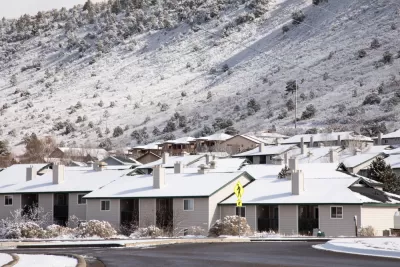A voter-approved measure will set aside existing tax revenue to support affordable housing projects, homeownership initiatives, and rental assistance programs.

Voters in Colorado approved a proposal to allocate existing tax revenue to supporting affordable housing, according to an article by Tatiana Flowers and Jesse Paul in the Colorado Sun.
“Proposition 123 will set aside up to 0.1% of taxable income each year for affordable housing. That’s estimated to be $145 million in the current fiscal year — which ends June 30, 2023 — and $290 million in 2023-24 and subsequent fiscal years.” Funds from the program will support affordable housing developments, homeownership assistance, and rental assistance and eviction defense programs.
The program comes as the median home price in the state rose to over $500,000, while apartment vacancy rates fell to as low as 2 percent, forcing renters to compete for few available units and move farther from their jobs and communities. As Flowers and Paul explain, “Denver’s homeless population grew 12.8% in the last two years, according to a recent local survey, and a gap between Black and white homeowners in Colorado has continued to widen since 1970.” Proponents hope this will speed up efforts to create more workforce housing for residents increasingly unable to afford housing.
The program has some caveats. “For projects to qualify for funding, local governments will have to commit to increasing affordable housing by 3% each year and will have to create a fast-track approval process for such projects.”
FULL STORY: Colorado voters approve ballot measure setting aside nearly $300 million each year for affordable housing

Alabama: Trump Terminates Settlements for Black Communities Harmed By Raw Sewage
Trump deemed the landmark civil rights agreement “illegal DEI and environmental justice policy.”

Planetizen Federal Action Tracker
A weekly monitor of how Trump’s orders and actions are impacting planners and planning in America.

The 120 Year Old Tiny Home Villages That Sheltered San Francisco’s Earthquake Refugees
More than a century ago, San Francisco mobilized to house thousands of residents displaced by the 1906 earthquake. Could their strategy offer a model for the present?

In Both Crashes and Crime, Public Transportation is Far Safer than Driving
Contrary to popular assumptions, public transportation has far lower crash and crime rates than automobile travel. For safer communities, improve and encourage transit travel.

Report: Zoning Reforms Should Complement Nashville’s Ambitious Transit Plan
Without reform, restrictive zoning codes will limit the impact of the city’s planned transit expansion and could exclude some of the residents who depend on transit the most.

Judge Orders Release of Frozen IRA, IIJA Funding
The decision is a victory for environmental groups who charged that freezing funds for critical infrastructure and disaster response programs caused “real and irreparable harm” to communities.
Urban Design for Planners 1: Software Tools
This six-course series explores essential urban design concepts using open source software and equips planners with the tools they need to participate fully in the urban design process.
Planning for Universal Design
Learn the tools for implementing Universal Design in planning regulations.
Clanton & Associates, Inc.
Jessamine County Fiscal Court
Institute for Housing and Urban Development Studies (IHS)
City of Grandview
Harvard GSD Executive Education
Toledo-Lucas County Plan Commissions
Salt Lake City
NYU Wagner Graduate School of Public Service





























